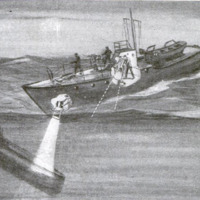Finding U-Boats in the Depths of the Sea
Contenuto
-
Titolo
-
Finding U-Boats in the Depths of the Sea
-
Article Title and/or Image Caption
-
Finding U-Boats in the Depths of the Sea
-
extracted text
-
“MAN the observing tube and watch sharply,” is the command given by the captain of the submarine chaser.
In the gloomy light his binocular has shown him a distant periscope and it behooves him to be cautious. Just behind a gun on the forward deck of the submarine chaser an observer takes a position at one end of a viewing tube which intersects the bottom of the vessel and enables him to sight objects under the surface of the water. He is aided by a viewing plate in the tube and a powerful electric searchlight behind lenses in the bottom of the vessel near the bow. The rays of light illuminate the depths of the ocean and reveal even small objects clearly. Valves are arranged to prevent water from entering the vessel and also to keep it in the tube close to the viewing plate in order to accentuate the visibility of objects through the tube.
The observer scans the depths for a time without result. At length, however, he glimpses a submarine many feet below. The submarine is moving slowly and the “chaser” adapts her speed to that of the U-boat. Quickly the chaser's commander gives orders for the release of a depth bomb. Through the tube the observer sees the death-machine drop on its mark. There follows a great disturbance of the waters where the submarine has been. Afterward the lenses reveal only dismembered parts of the submarine.
It is thus that Alexander Egenes of Lower Rochester, Nevada, would combat the submarine menace; for he has invented a submarine chaser which embodies the features unfolded in the foregoing description. But Egenes forgets many things. In the first place, electric lights have no great penetrating power in water. In the second place, the waters of the North Sea and the North Atlantic Ocean are usually so rough that even if
the most powerful searchlights could be directed downward, nothing but murkiness could be seen.
-
Autore secondario
-
Alexander Egenes (inventor)
-
Lingua
-
eng
-
Data di rilascio
-
1918-07
-
pagine
-
27
-
Diritti
-
Public Domain (Google digitized)
-
Archived by
-
Filippo Valle
-
Alberto Bordignon (Supervisor)
 Under-water telescope
Under-water telescope